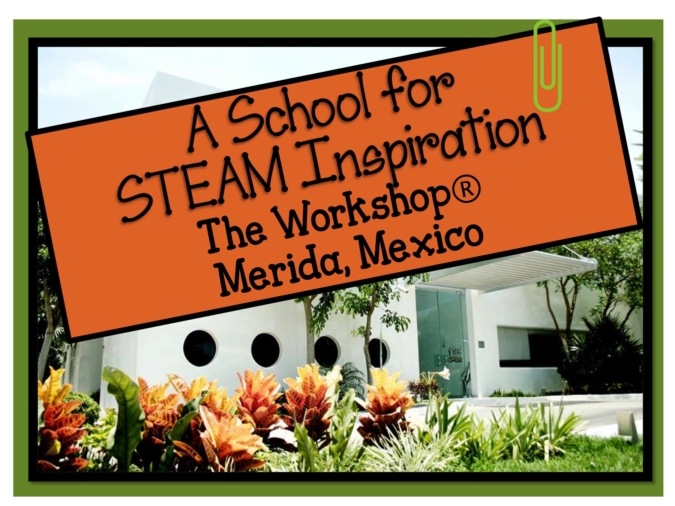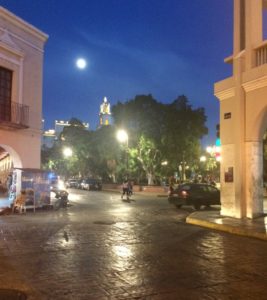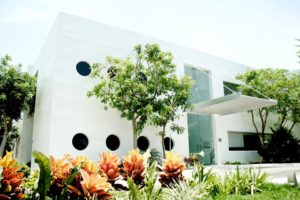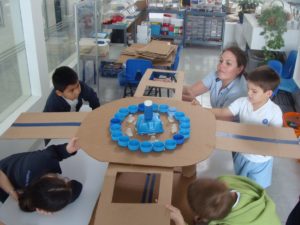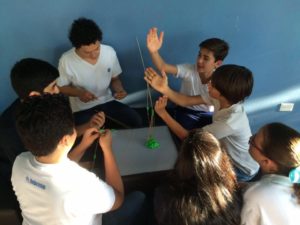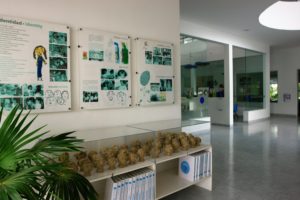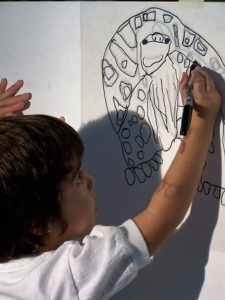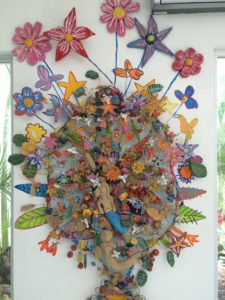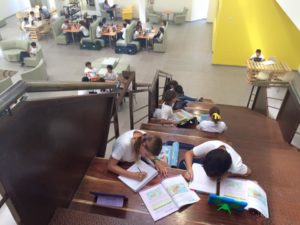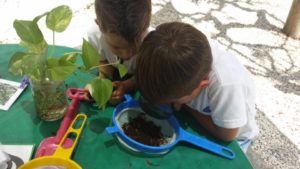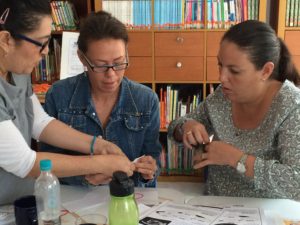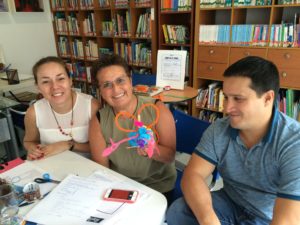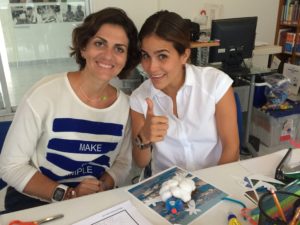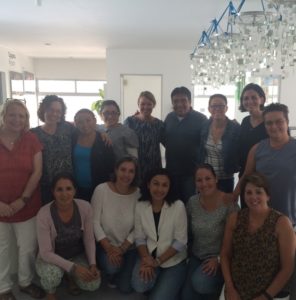For many, the Yucatan Peninsula brings to mind adventures and excursions from the extraordinary archeological sites of the Mayan culture to the lovely resorts of Cancun. We were recently surprised to discover that a very different reason to travel to the Yucatan existed. Located in the northwest part of the state is the picturesque city of Merida. Not only is it the capital, but it is also home to one amazing school. Last month, we had the pleasure of visiting The Workshop ®, a coed private school serving toddlers through 9th graders that is founded on the theory of social constructivism and John Dewey. This approach asks children to learn through their interactions with their peers. The teacher serves as a facilitator among a collaborative group of children. The approach is founded on the principle that social skills must be developed in young children as a preliminary objective to any learning.  For example, the younger students are free to “take a break” and leave their classroom and sit and observe the turtles if they are feeling stressed or need a minute to relax. At present, The Workshop is comprised of two campuses, one in Merida for students age 1 through 5thhgrade, and one in Komchen for middle school students in grades 6th-9th.
For example, the younger students are free to “take a break” and leave their classroom and sit and observe the turtles if they are feeling stressed or need a minute to relax. At present, The Workshop is comprised of two campuses, one in Merida for students age 1 through 5thhgrade, and one in Komchen for middle school students in grades 6th-9th.  They have just reached an agreement with the University of Texas to expand their curriculum through high school and allow their students to take online courses at UT. They will graduate with both a US High School Diploma as well as one from Mexico. As we began to learn about The Workshop® prior to our visit last month, we wondered what we could possibly contribute to a school that has a habit of doing things like inviting an MIT professor to work with sixth graders to create organs that utilize synthetic blood pumps. Although the students received computer technology instruction from an early age and the older students had opportunities to work with professional engineers, Caty wanted us to work with teacher leaders to help them learn how to integrate engineering into their curriculum. We began our week at The Workshop® with some apprehension. Arriving with suitcases full of materials we hoped were going to meet expectations, we worried about how the teachers would receive our ideas. Oh and did we mention that we don’t speak a word of Spanish? Upon meeting Caty and the rest of her staff, any anxieties we had disappeared as we realized that everyone from the administrators to the teacher leaders were enthusiastic about our arrival.Our days with the staff were jam packed with many ideas to integrate engineering into their curriculum.
They have just reached an agreement with the University of Texas to expand their curriculum through high school and allow their students to take online courses at UT. They will graduate with both a US High School Diploma as well as one from Mexico. As we began to learn about The Workshop® prior to our visit last month, we wondered what we could possibly contribute to a school that has a habit of doing things like inviting an MIT professor to work with sixth graders to create organs that utilize synthetic blood pumps. Although the students received computer technology instruction from an early age and the older students had opportunities to work with professional engineers, Caty wanted us to work with teacher leaders to help them learn how to integrate engineering into their curriculum. We began our week at The Workshop® with some apprehension. Arriving with suitcases full of materials we hoped were going to meet expectations, we worried about how the teachers would receive our ideas. Oh and did we mention that we don’t speak a word of Spanish? Upon meeting Caty and the rest of her staff, any anxieties we had disappeared as we realized that everyone from the administrators to the teacher leaders were enthusiastic about our arrival.Our days with the staff were jam packed with many ideas to integrate engineering into their curriculum.
Upon our arrival, we met Caty Franco, the owner and director of the school, and spent three full days enjoying our discussions about education, STEAM and how best to integrate engineering into a curriculum already brimming with arts integration, as well as science and technology. We spent our week not only conducting workshops but also emerging ourselves in the philosophy of her school
“In order to be successful in life, children have to be skillful in listening and communicating to each other. They must understand the importance of diversity among people, taking into consideration that each person working in the collaborative group, has different ideas that will help to solve problems through critical and creative thoughts.” Caty Franco, Director of The Workshop® Walking into the school, one is immediately aware that this is a unique place of learning. The physical building is filled with light and art. Large classrooms with rows of desks are replaced by small rooms with lots of floor space, tables for students to work and shelves that are filled with objects to serve as explorations for students. The outer walls and hallways have large windows that not only let in abundant sunshine but also allow students to look straight to the other side of the school to see friends and students. An outside garden area is home to turtles for younger students to feed and take care of. Caty espouses that the building is a symbol of the school’s philosophy that there is transparency in the education of their students. The 320 students who attend The Workshop® receive lessons in both English and Spanish; the students are fluent in English by third grade. By sixth grade, they have begun to learn French as well. Art is heavily integrated into their curriculum as the students use it as a means to express their learning. The walls, doors and even the ceilings, are filled with art created by the students, which Caty explains in this way: “Art and the thoughts of children are placed on walls for children to feel a sense of belonging and for the adults to recognize that each child is capable to achieve goals. We incorporate the philosophy of Loris Malaguzzi as art is also a memory of what children have learned; it is the representation of children knowledge and skills. Art is part of an inter-disciplinary program that is part of our educational approach. Most of the art pieces that are around the building are achieved in collaborative groups, giving children the vision to understand that thoughts can be represented with different media including the use of technology.” Although students learn the usual subjects such as reading and math, it’s how the students spend their day learning that is remarkable. The day is divided into three hour blocks for each subject. Students don’t spend time memorizing facts that can easily be looked up; rather, the emphasis is on learning how to learn. The city of Merida serves as an extension of the school; students take frequent field trips into the city to integrate its art, architecture and history into their curriculum. This helps children to develop their cultural and social history. How did such a unique school come into being? Twenty eight years ago, Caty Franco worked in traditional schools that had groups of sixty students to a class. She explains, “In this experience I found my own strategies to divide the group into small collaborative groups. I observed how students changed their attitude toward learning, so I decided to create a school with a creative program. I developed an approach where children receive personal attention, teachers would be companions in the process of the children’s learning and art would be part of their learning.” Studying such educational pioneers as John Dewey, Lev Vigotsky and Jean Piaget, as well as observing students’ learning processes, Caty has carefully created a curriculum that allows the students to learn through collaboratively. Learning about themselves and their place in society is a priority for the students. They are encouraged to both set goals for their learning and recognize methods for achieving their goals. Students are responsible for their behavior.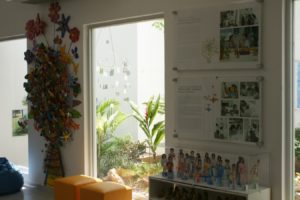 For example, the younger students are free to “take a break” and leave their classroom and sit and observe the turtles if they are feeling stressed or need a minute to relax. At present, The Workshop is comprised of two campuses, one in Merida for students age 1 through 5thhgrade, and one in Komchen for middle school students in grades 6th-9th.
For example, the younger students are free to “take a break” and leave their classroom and sit and observe the turtles if they are feeling stressed or need a minute to relax. At present, The Workshop is comprised of two campuses, one in Merida for students age 1 through 5thhgrade, and one in Komchen for middle school students in grades 6th-9th. 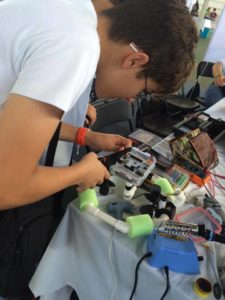 They have just reached an agreement with the University of Texas to expand their curriculum through high school and allow their students to take online courses at UT. They will graduate with both a US High School Diploma as well as one from Mexico. As we began to learn about The Workshop® prior to our visit last month, we wondered what we could possibly contribute to a school that has a habit of doing things like inviting an MIT professor to work with sixth graders to create organs that utilize synthetic blood pumps. Although the students received computer technology instruction from an early age and the older students had opportunities to work with professional engineers, Caty wanted us to work with teacher leaders to help them learn how to integrate engineering into their curriculum. We began our week at The Workshop® with some apprehension. Arriving with suitcases full of materials we hoped were going to meet expectations, we worried about how the teachers would receive our ideas. Oh and did we mention that we don’t speak a word of Spanish? Upon meeting Caty and the rest of her staff, any anxieties we had disappeared as we realized that everyone from the administrators to the teacher leaders were enthusiastic about our arrival.Our days with the staff were jam packed with many ideas to integrate engineering into their curriculum.
They have just reached an agreement with the University of Texas to expand their curriculum through high school and allow their students to take online courses at UT. They will graduate with both a US High School Diploma as well as one from Mexico. As we began to learn about The Workshop® prior to our visit last month, we wondered what we could possibly contribute to a school that has a habit of doing things like inviting an MIT professor to work with sixth graders to create organs that utilize synthetic blood pumps. Although the students received computer technology instruction from an early age and the older students had opportunities to work with professional engineers, Caty wanted us to work with teacher leaders to help them learn how to integrate engineering into their curriculum. We began our week at The Workshop® with some apprehension. Arriving with suitcases full of materials we hoped were going to meet expectations, we worried about how the teachers would receive our ideas. Oh and did we mention that we don’t speak a word of Spanish? Upon meeting Caty and the rest of her staff, any anxieties we had disappeared as we realized that everyone from the administrators to the teacher leaders were enthusiastic about our arrival.Our days with the staff were jam packed with many ideas to integrate engineering into their curriculum.STEM and Animal Adaptations
https://www.teacherspayteachers.com/Product/
They were relieved to learn that engineering activities didn’t need to be very complicated or have a lot of specialized materials to have lasting meaning or impact. Teachers were also pleasantly surprised to find out that much of what they were already doing in their classrooms could be easily expanded to include engineering skills. Teachers displayed a commitment to their students learning during our entire workshop. And in the evenings, Caty ushered us around her beautiful city so that we would get a taste of what Merida had to offer. At the end of the week, we were sad to leave the warm and engaging faculty of The Workshop® who had so generously welcomed us into their school. We were in awe of their creativity, inspired by their philosophy, and delighted by their joy, sense of humor, and enthusiasm. It was an amazing opportunity for us and we look forward to returning soon.What They Say

Wendy came to Bellevue Arts Museum to co-lead our Full STEAM Ahead! Summer Camp in August 2014. This camp was a huge success thanks to her expertise, experience, and warmth working with the campers throughout the week…
MEGAN DYE
Educational Outreach Director, The Bellevue Art Museum, Bellevue, Washington


